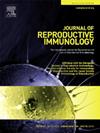Association of elevated ACSL4 expression with impaired endometrial receptivity in endometriosis and restoration by ACSL4 inhibitor PRGL493
IF 2.9
3区 医学
Q3 IMMUNOLOGY
引用次数: 0
Abstract
This study investigated the role of ACSL4 in endometrial receptivity disorders in endometriosis (EMs) and evaluated PRGL493, an ACSL4 inhibitor, as a potential therapeutic target. Bioinformatic analysis identified ACSL4 as a potential key regulator among ferroptosis and receptivity-related genes. Clinical samples from EMs patients showed significantly higher endometrial ACSL4 expression and lower receptivity marker expression (αVβ3, OPN, HOXA10) compared to controls. In a mouse EMs model, PRGL493 treatment reduced lesion volume, decreased lipid peroxidation, increased pinopode formation, and improved expression of receptivity markers. Similarly, in human endometrial organoids from EMs patients, PRGL493 ameliorated ultrastructural abnormalities, including mitochondrial condensation, decreased secretory granules, and endoplasmic reticulum expansion, and restored receptivity marker expression to levels comparable to the control. These findings demonstrate that ACSL4 overexpression is associated with endometrial receptivity disorders in EMs and that ACSL4 overexpression is a key pathological feature linked to endometrial receptivity impairment in EMs. Targeting ACSL4 with PRGL493 ameliorates receptivity defects, suggesting its therapeutic potential for EMs-associated infertility.
ACSL4表达升高与子宫内膜异位症子宫内膜容受性受损的关系及ACSL4抑制剂PRGL493的修复
本研究探讨了ACSL4在子宫内膜异位症(EMs)患者子宫内膜容受性障碍中的作用,并评估了ACSL4抑制剂PRGL493作为潜在的治疗靶点。生物信息学分析发现ACSL4是铁下垂和接受性相关基因中潜在的关键调节因子。EMs患者的临床样本显示,与对照组相比,子宫内膜ACSL4表达明显升高,接受性标志物αVβ3、OPN、HOXA10表达明显降低。在小鼠EMs模型中,PRGL493治疗减少了病变体积,减少了脂质过氧化,增加了pinopes的形成,并改善了受体标记物的表达。同样,在EMs患者的人子宫内膜类器官中,PRGL493改善了超微结构异常,包括线粒体凝聚、分泌颗粒减少和内质网扩张,并将接受性标志物的表达恢复到与对照组相当的水平。这些研究结果表明,ACSL4过表达与EMs中子宫内膜容受性障碍有关,并且ACSL4过表达是与EMs中子宫内膜容受性障碍相关的关键病理特征。PRGL493靶向ACSL4可改善受体缺陷,提示其治疗ems相关不孕症的潜力。
本文章由计算机程序翻译,如有差异,请以英文原文为准。
求助全文
约1分钟内获得全文
求助全文
来源期刊
CiteScore
6.30
自引率
5.90%
发文量
162
审稿时长
10.6 weeks
期刊介绍:
Affiliated with the European Society of Reproductive Immunology and with the International Society for Immunology of Reproduction
The aim of the Journal of Reproductive Immunology is to provide the critical forum for the dissemination of results from high quality research in all aspects of experimental, animal and clinical reproductive immunobiology.
This encompasses normal and pathological processes of:
* Male and Female Reproductive Tracts
* Gametogenesis and Embryogenesis
* Implantation and Placental Development
* Gestation and Parturition
* Mammary Gland and Lactation.

 求助内容:
求助内容: 应助结果提醒方式:
应助结果提醒方式:


